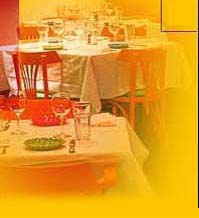


|
Eating Out...
|
|
One of the most interesting aspects of food is how integral it is to a particular culture and to a broader perception of how we view a nationality. Italian food when I grew up represented conviviality, a certain rustic charm, pasta and pizza, and family-run restaurants with jolly patrons who loved children. One enjoyed not just the food, but also the casual, friendly atmosphere. Of course, there are thousands of trattoria in this world which keep to this image; no nonsense food, reasonable and freshly made. However, the image of Italy in the last few years has changed. With Milan now the designer capital of the world, with a cutting-edge quality, a vibrancy, and sleekness which signals a new efflorescence and ostentation about Italian culture, which has influenced not just the restaurants, but also the food and its presentation. I would say that today Italy is going through its second renaissance; if there’s no Michelangelo, there’s at least an Armani.
One has seen how Italian restaurants have changed their image, often showcasing the most innovative of Italian design. My first experience of this was a restaurant in Dubai called La Moda in the Intercontinental. This was straight from Milan and the cuisine was influenced by the great new Italian chef, Cavallini from the Halkin in London and the Marchesi in Italy. So far, we have not really seen this kind of a restaurant in India; the restaurants are often faux imitations of Tuscan kitchens, rough plaster with limewash, copper sauce pans on the wall and the rustic table and chairs. The classic example being La Piazza at the Hyatt in Delhi and, to a lesser extent, the Trattoria at the Taj President in Bombay. Now with the entry of Vetro, just opened at the Oberoi, all that has changed. ‘Vetro’ is Italian for glass and as this is modern Italian, the glasswork is very slick and contemporary as is the whole make-up of the restaurant. Mama mia slaving in the kitchen has been replaced by chef Emanuel Lattanzi — his name even sounds like an Italian racing car, at least a style icon of sorts.
I mentioned Cavallini who is the contemporary master of modern Italian cooking and it is relevant that Chef Lattanzi has worked under the master in the Halkin in London; there are many touches of Cavallini in the menu. I have not eaten at the Halkin, but at a another rather fine restaurant which is heavily influenced by Cavallini, Teca at Brooks Mews in Mayfair, London. Vetro has replaced the Rotisserie, the great French fine-dining restaurant at the Oberoi, and is located next to the lobby which itself is arguably one of the more stunning in India. The entrance is marked by a casual sofa arrangement and a compact wine library called an Enoteca which stocks a fair range of quality Italian wines, around 900 in all. The flooring of the restaurant serves to lighten the place with the cool hue of the crema marfil, a marble flooring, lacquer finished panels. All this creaminess and lightness is set off by the most exquisite Venetian glass screens glowing with the striking colours of maroon and amber. This is the signature artefact of the restaurant, the reason for its name, and it lends a warm quality to the decor as well. This touch is inspired as my complaint with much of contemporary minimalism is that it is too bleak, and in the Indian context, positively depressing.
The intention as befits a Hassler tie up, which among other things boasts a school of wine and food, is to introduce and showcase the best of Italian wines. To be fair to the restaurant, it has only recently opened and the full stock was not available. But there are some very interesting wines, including several delicious Amarones, a wine from Verona, a region famous for the Valpolicella Classico, and another great wine from the region also present was the Bardolino. The whites included a Gavi Di Gavi, a Pinot Grigio, (a white wine made from a black Vetro has a marvellous and generous but discriminating selection of anti pasta, and indeed, one of the bargains is that you can have the anti pasta selection for lunch, since eating healthy is the new mantra. On my several visits to the restaurant, the anti pasta I liked the most was the broccoli with the smoked duck. There were the usual suspects, the Caprese (with buffalo mozzarella, tomato and basil) and the Carpaccio and some very inspired salads including a seafood salad. They also serve the freshest and finest Parma ham which you can slice bits off, as well as some excellent parmesan cheese. According to the great Anthony Bourdain, in Chef’s Confidential advises never to eat bread in restaurants for health reasons, as some restaurants have a habit of recycling their bread baskets. Well, at Vetro there was no danger of that. The bread was freshly baked and arrived hot at the table, including which was a particularly memorable Ciabetta. For my first course, I ordered an old favourite, the Filetto de vitello tonnato. This was the first time I’d seen it on an Indian menu. It consists of thin slices of veal with a tuna sauce. It doesn’t sound great but the combination is magical. The sauce includes anchovies, lemon and capers, and has a tart quality to it. It also looked like it should, though the meat was described as young tenderloin. This is the politically-correct term and not veal, though I suspect it was imported veal. I had a glass of the Pinot Grigio with this and it was excellent. I had a little bit of the fois de gras which was outstanding; it compared very favourably with a fois de gras I’d had in the Michelin starred Marco Fadigo in Bologna, velvety-smooth with the most exquisite taste. For the main course, I had the Squid Ink Risotto which is a classic, called Nero di seppia in Italian; this is used for colouring food such as risotto and pasta. On an earlier visit I’d ordered a Garoupa which was served with a fennel sauce. I have always maintained that the combination of fennel with fish works beautifully. My companion on that occasion opted for a Yellow fin Tuna Carpaccio that was extraordinarily subtle.
On another visit, I opted for the fish, which was slightly less satisfactory. I had ordered the Norwegian salmon, which was grilled and served with a broccoli sauce; although I adore broccoli in principle, the sauce did not quite work. It tasted perilously like mushy peas. The fillets of salmon were served with yellow peppers and zucchini — the presentation was exquisite. My companion ordered the Tenderloin with Roma tomatoes and Rocket. The Roma tomatoes are typically Roman, tomatoes marinated in basil-infused olive oil, and have a sweetness which works very well with the peppery quality of the Rocket. The Tenderloin is imported beef from South Australia and was served in the Italian fashion, in slices and was delicious, at least that’s what my friend told me and he is quite a connoisseur. The desserts all looked quite fabulous, traditional ones like the Zablioni and Tiramisu, but I must confess I did not partake. In all, I enjoyed the experience and it is gratifying that India is now on the gastronomic map, with chefs having the training and background of Emanuel Lattanzi coming to work in India.
|

Home Page
About the mag
Subscribe
Advertise
Contact Us
 Gourmet JAVED GAYA visits Bombay’s new Italian restaurant, the Vetro at the Oberoi, and discovers the true taste of Italy in India.
Gourmet JAVED GAYA visits Bombay’s new Italian restaurant, the Vetro at the Oberoi, and discovers the true taste of Italy in India.